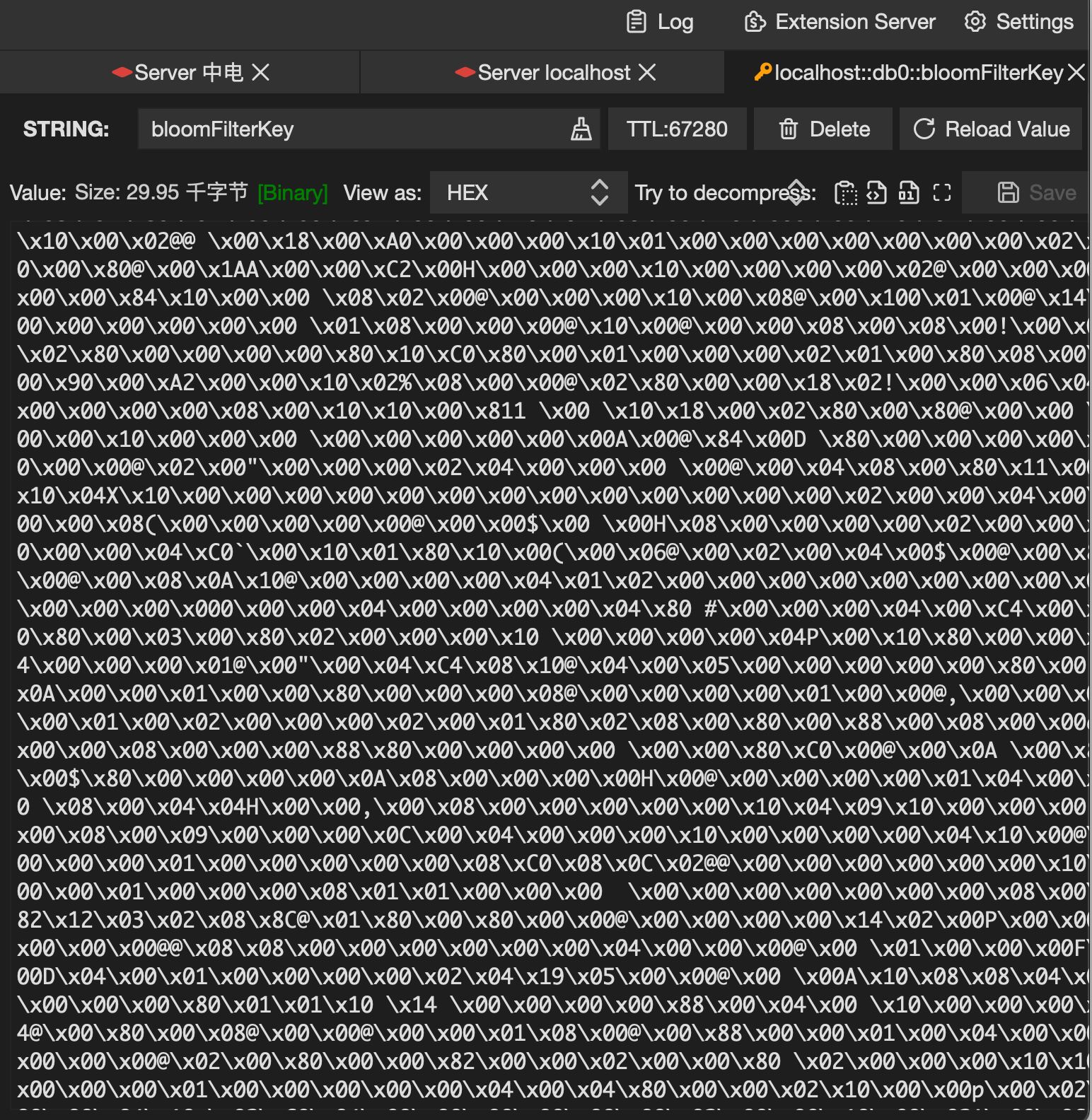布隆过滤器持久化到redis
目录
布隆过滤器持久化到redis
关于布隆过滤器的介绍网上基本上都能找到。
运用guava包下面的布隆过滤器来模拟
持久化思路
将布隆过滤器中的下标数组存储到redis的bitMap中
引入guava依赖
<dependency>
<groupId>com.google.guava</groupId>
<artifactId>guava</artifactId>
<version>32.1.2-jre</version>
</dependency>查看一下bloomFilter的mightContain方法
public <T> boolean mightContain(@ParametricNullness T object, Funnel<? super T> funnel, int numHashFunctions, LockFreeBitArray bits) {
long bitSize = bits.bitSize();
long hash64 = Hashing.murmur3_128().hashObject(object, funnel).asLong();
int hash1 = (int)hash64;
int hash2 = (int)(hash64 >>> 32);
for(int i = 1; i <= numHashFunctions; ++i) {
int combinedHash = hash1 + i * hash2;
if (combinedHash < 0) {
combinedHash = ~combinedHash;
}
if (!bits.get((long)combinedHash % bitSize)) {
return false;
}
}
return true;
}后面计算数组下标需要用到
查看一下com.google.common.hash.BloomFilter#optimalNumOfHashFunctions计算hash函数个数需要
@VisibleForTesting
static int optimalNumOfHashFunctions(long n, long m) {
// (m / n) * log(2), but avoid truncation due to division!
return Math.max(1, (int) Math.round((double) m / n * Math.log(2)));
}根据给定的 bitSize 和 p 计算出最优的位数com.google.common.hash.BloomFilter#optimalNumOfBits
/**
* 根据给定的 bitSize 和 p 计算出最优的位数
*
* 这个公式是基于信息论中的熵(Entropy)概念来计算最优位数的。熵是衡量信息量的一种度量方式,可以理解为信息的平均编码长度。
* 在这个公式中, bitSize 表示位大小, p 表示概率。根据信息论的原理,当概率分布越均匀时,信息熵越大,需要更多的位数来表示。相反,当概率分布越集中在某些特定值时,信息熵越小,需要较少的位数来表示。
* 公式中的 Math.log(p) 表示以e为底的对数, Math.log(2) 表示以e为底的对数。通过将概率 p 的对数除以 Math.log(2) ,我们可以将其转换为以2为底的对数,这样可以得到以2为底的熵值。
* 然后,通过将 bitSize 乘以概率的对数,再除以以2为底的熵值,我们可以得到最优位数。
* 这个公式的依据是信息论的基本原理,它提供了一种根据概率分布来计算最优位数的方法。在某些情况下,这个公式可以帮助我们确定需要多少位来表示特定的信息,以便在存储或传输数据时进行优化。
* @param bitSize
* @param p
* @return
*/
private int optimalNumOfBits(long bitSize, double p){
if(p == 0){
p = Double.MIN_VALUE;
}
return (int) (-bitSize * Math.log(p) / (Math.log(2) * Math.log(2)));
}创建BloomFilterFactory
murmurHashOffset方法用来获取key的hash的下标数组
public int[] murmurHashOffset(T value) {
int[] offset = new int[numHashFunctions];
long hash64 = Hashing.murmur3_32_fixed().hashObject(value, funnel).padToLong();
int hash1 = (int) hash64;
int hash2 = (int) (hash64 >>> 32);
for (int i = 1; i <= numHashFunctions; i++) {
int nextHash = hash1 + i * hash2;
if (nextHash < 0) {
nextHash = ~nextHash;
}
offset[i - 1] = nextHash % bitSize;
}
return offset;
}完整代码
package com.example.spring.boot.test.bloomfilter;
import com.google.common.base.Preconditions;
import com.google.common.hash.Funnel;
import com.google.common.hash.Hashing;
/**
* @Description
* @Author wuhuaming
* @Date 2023/9/8
*/
public class BloomFilterFactory<T> {
/**
* hash函数的个数
*/
private int numHashFunctions;
/**
* 最优数组大小
*/
private int bitSize;
private Funnel<T> funnel;
public BloomFilterFactory(Funnel<T> funnel, int expectedInsertions, double fpp) {
Preconditions.checkArgument(funnel != null, "funnel不能为空");
this.funnel = funnel;
bitSize = optimalNumOfBits(expectedInsertions, fpp);
numHashFunctions = optimalNumOfHashFunctions(expectedInsertions, bitSize);
}
public int[] murmurHashOffset(T value) {
int[] offset = new int[numHashFunctions];
long hash64 = Hashing.murmur3_32_fixed().hashObject(value, funnel).padToLong();
int hash1 = (int) hash64;
int hash2 = (int) (hash64 >>> 32);
for (int i = 1; i <= numHashFunctions; i++) {
int nextHash = hash1 + i * hash2;
if (nextHash < 0) {
nextHash = ~nextHash;
}
offset[i - 1] = nextHash % bitSize;
}
return offset;
}
/**
* 根据给定的 bitSize 和 p 计算出最优的位数
*
* 这个公式是基于信息论中的熵(Entropy)概念来计算最优位数的。熵是衡量信息量的一种度量方式,可以理解为信息的平均编码长度。
* 在这个公式中, bitSize 表示位大小, p 表示概率。根据信息论的原理,当概率分布越均匀时,信息熵越大,需要更多的位数来表示。相反,当概率分布越集中在某些特定值时,信息熵越小,需要较少的位数来表示。
* 公式中的 Math.log(p) 表示以e为底的对数, Math.log(2) 表示以e为底的对数。通过将概率 p 的对数除以 Math.log(2) ,我们可以将其转换为以2为底的对数,这样可以得到以2为底的熵值。
* 然后,通过将 bitSize 乘以概率的对数,再除以以2为底的熵值,我们可以得到最优位数。
* 这个公式的依据是信息论的基本原理,它提供了一种根据概率分布来计算最优位数的方法。在某些情况下,这个公式可以帮助我们确定需要多少位来表示特定的信息,以便在存储或传输数据时进行优化。
* @param bitSize
* @param p
* @return
*/
private int optimalNumOfBits(long bitSize, double p){
if(p == 0){
p = Double.MIN_VALUE;
}
return (int) (-bitSize * Math.log(p) / (Math.log(2) * Math.log(2)));
}
/**
* 计算hash方法执行次数
*/
private int optimalNumOfHashFunctions(long n, long m) {
return Math.max(1, (int) Math.round((double) m / n * Math.log(2)));
}
}创建 BloomFilterService
package com.example.spring.boot.test.bloomfilter;
import com.google.common.base.Preconditions;
import lombok.extern.slf4j.Slf4j;
import org.springframework.beans.factory.annotation.Autowired;
import org.springframework.beans.factory.annotation.Value;
import org.springframework.data.redis.core.RedisTemplate;
import org.springframework.stereotype.Service;
import java.util.concurrent.TimeUnit;
/**
* @author wuhuaming
*/
@Slf4j
@Service
public class BloomFilterService {
@Value("${bloomFilter.expiration:24}")
private long expiration;
@Autowired
private RedisTemplate redisTemplate;
/**
* 根据给定的布隆过滤器添加值
*/
public <T> void addByBloomFilter(BloomFilterFactory<T> bloomFilterHelper, String key, T value) {
Preconditions.checkArgument(bloomFilterHelper != null, "bloomFilterHelper不能为空");
int[] offset = bloomFilterHelper.murmurHashOffset(value);
for (int i : offset) {
redisTemplate.opsForValue().setBit(key, i, true);
}
//由于setBit不能直接设置过期时间,因此另外再设置
//返回值expire为-1时 此键值没有设置过期日期
//返回值expire为-2时 不存在此键
long expire = redisTemplate.opsForValue().getOperations()
//此方法返回单位为秒过期时长
.getExpire(key);
if (expire == -1 ){
redisTemplate.expire(key, expiration, TimeUnit.HOURS);
}
}
/**
* 根据给定的布隆过滤器判断值是否存在
*/
public <T> boolean includeByBloomFilter(BloomFilterFactory<T> bloomFilterHelper, String key, T value) {
Preconditions.checkArgument(bloomFilterHelper != null, "bloomFilterHelper不能为空");
int[] offset = bloomFilterHelper.murmurHashOffset(value);
for (int i : offset) {
if (!redisTemplate.opsForValue().getBit(key, i)) {
return false;
}
}
return true;
}
}测试
@Test
public void test7(){
BloomFilterFactory<String> bloomFilterHelper = new BloomFilterFactory<>((Funnel<String>) (from, into) -> into.putString(from, Charsets.UTF_8), 10000, 0.00001);
String key = "bloomFilterKey";
for(int i = 0; i< 1000; i++){
boolean flag = bloomfilterService.includeByBloomFilter(bloomFilterHelper, key, "bloomFilter" + i);
if(!flag){
bloomfilterService.addByBloomFilter(bloomFilterHelper, key, "bloomFilter" + i);
}
}
System.out.println(bloomfilterService.includeByBloomFilter(bloomFilterHelper, key, "bloomFilter1"));
}查看redis:

测试结果
@Test
public void test7(){
BloomFilterFactory<String> bloomFilterHelper = new BloomFilterFactory<>((Funnel<String>) (from, into) -> into.putString(from, Charsets.UTF_8), 10000, 0.00001);
String key = "bloomFilterKey";
System.out.println(bloomfilterService.includeByBloomFilter(bloomFilterHelper, key, "bloomFilter1"));
}true